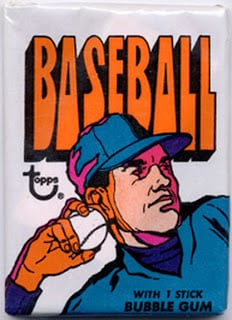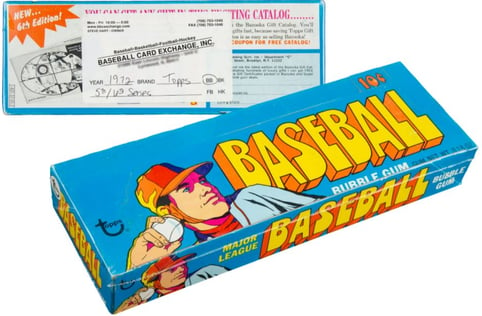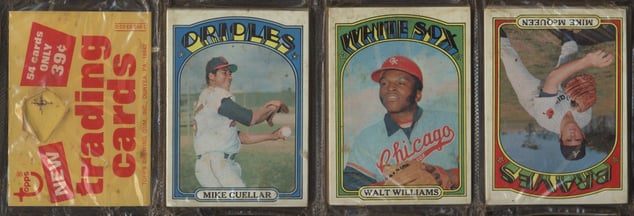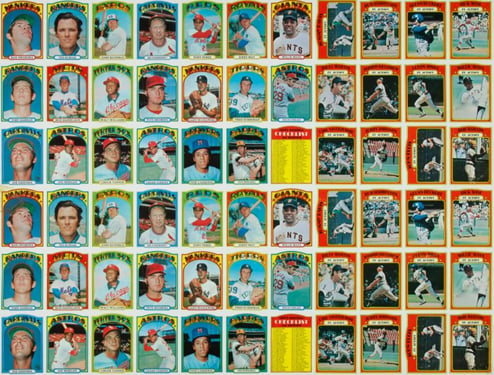1972 Topps Trivia
One word that describes the 1972 Topps baseball cards would be “loud.” It is hard to miss the bright, colorful borders and fresh design highlighting the uniqueness of that decade. Metaphorically perhaps, this set represents a combination of the expressive and artistic moments of the late 1960s and early 1970s.
The 1972 Topps set was unique. It is among the biggest and most colorful sets from any that Topps ever produced. It was the largest to that point and contained many new subsets for the collector to enjoy. The first series had a solid selection of stars, but most importantly it contained the rookie card for future Hall of Famer, Carlton Fisk. In all, there were 6 series that were released from the late winter/early spring into the late summer months.
While the Fisk rookie gets the attention, this set was loaded with legends such as Willie Mays (#49), Roberto Clemente (#309), Reggie Jackson (#435) and Hank Aaron. In addition, the traded series (high series) featured three future Hall of Famers in Steve Carlton (#751), Joe Morgan (#752) and Frank Robinson (#754).
#1. Which is worth more: a PSA 10 Graded 1972 Topps Nolan Ryan or Carlton Fisk?

A PSA 10 graded Carlton Fisk is worth substantially more than a PSA 10 Nolan Ryan.
While the (relatively) high numbered Ryan has sold for more than $7,500, the Fisk on the other hand has sold for just shy of $50,000. The PSA 10 Fisk rookie is a rare card with only 10 achieving that elusive grade.
#2. How many cards are in a 1972 Topps Baseball Wax Pack?
There were 10 cards in a 1972 Topps baseball wax pack. In addition, there were 24 wax packs in a wax box. The packs cost 10 cents a piece back in 1972. Today, a high grade 1972 PSA pack will cost you somewhere between $400 - $1000+ depending on the series, player showing and condition.

#3. How many cards were in a 1972 Topps baseball Cello Pack?

There were 30 cards in a 1972 Topps baseball cello pack. This was the last year of the “boxed” cellos. These packs consisted of 30 cards, a stick of gum and were wrapped in clear, non-marked cellophane, which was then placed in a little blue, outer box. There were 24 of these “boxed cellos” in a full (red colored) cello box. 1972 was the final year a cardboard casing would be used for packaging.
#4. How many series did 1972 Topps Baseball consist of?

The 1972 Topps baseball set consisted of 6 series, contrary to 7 which was the norm then. The 1972 Topps started with a late winter release of series 1, and it didn’t end until late summer with the 6th series. As had been the norm, collector interest in the higher numbered series waned as seasons changed and the focus shifted to football. Thus, the high-numbered cards-maintained scarcity, with series 5 (#536-656) and 6 (#657-787) being difficult to find in today’s environment.
#5. How many cards did a 1972 Topps Baseball Rack Pack include?

There were 54 cards in a 1972 Topps rack pack. The cost of that rack was 39cents. It’s interesting to note that Topps produced these across a variety of series, but these are fairly rare to find in the market today. In fact, all Topps rack packs from 1974 and earlier are pretty difficult to find in today’s market.
#6. If you had a complete 1972 Topps baseball set, how many cards would you have in total?

The 1972 Topps Baseball set was comprised of 787 cards. Topps was in an expansion mode and upgraded from producing a 720-card set in 1970, 752 in 1971, and it culminated with a 787-card set for 1972.
#7. The 1972 Topps Baseball set is also known for having multiple subsets. How many subsets were there?

The 1972 Topps series offered about 9 subsets. It offered the usual team cards, rookie stars, league leaders and postseason review cards. Apart from the standard subset options such as the league leaders (#85-96) and playoffs/world series highlights (#221-230), lots of new themes have emerged.
Boyhood photos of the stars (#341-#348, #491-498) featured childhood photos and pre-MLB bio for chosen players. Awards cards (#621-626) show top trophies in the game and featured a full list of winners till then. The last series featured traded cards (#751-757), highlighting a handful of players that switched teams.
Conclusion
The 1972 Topps was a welcomed change from the relatively colorless sets that started in the late 1960’s. The nickname “psychedelic tombstone” is appropriate given its outer border design, and how each picture is framed within an arch.
Some collectors love this while others have found the flashy design tacky. Regardless of the opinion, this set represents the style of the decade it was produced.
Want to continue reading? Here are a few posts you might find interesting:
- 1970 Topps Baseball: Everything You Want To Know
- 1971 Topps Baseball: Everything You Wanted To Know
- A Look Back At The 1986-87 Fleer Basketball Set
- 1989 Ken Griffey Jr. Rookie: The Improbable Foresight of Upper Deck
- Ichiro Suzuki Rookie: What is the value of "Once in a Lifetime Cards?"
- Investing In Fleer Michael Jordan Cards? Here Is What You Need To Know


